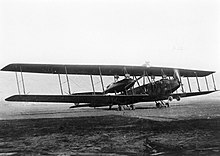Experimental building Gotha East
The Versuchsbau Gotha Ost (VGO) was a division of the Gotha Coach Factory to build giant aircraft which the first test samples for later Zeppelin Staaken R.VI created.
prehistory
Before the First World War, the Russian Ilya Muromets designed by Igor Sikorsky in 1912/13 was the only type of large aircraft in the world. Despite the fixation on airships, Germany was well aware that the future would belong to airplanes. So in 1914 the industrialists Ferdinand Graf von Zeppelin , Robert Bosch and Albert Hirth hired Germany's first professor of aircraft construction, Alexander Baumann, to head the project. They were joined by Hellmuth Hirth and the young Ernst Heinkel. The first fully functional giant aircraft emerged which far exceeded the Russian model in terms of size and payload. By the end of the war, 34 of these aircraft had been built in series, including 18 of the Zeppelin-Staaken R.VI.
VGO I
The VGO I was a four-stemmed double-decker with a wingspan of 42 meters. The tail unit was also designed as a double-decker with double rudder. The construction consisted mainly of wood. It was powered by three Maybach Mb IV engines from Maybach-Motorenbau, which was co-founded by Zeppelin , with 240 hp each. One engine was in the nose of the fuselage and the other two in nacelles between the wings. The nacelle motors drove compressed air screws. The machine was ordered by the Navy and received the identification RML1. The first flight took place on April 11, 1915. Initial attempts at deployment took place on the Eastern Front and were reasonably satisfactory. However, there was a clear under-motorization, whereupon the machine was transferred back to Staaken and subjected to a conversion measure. Two more engines were installed, but during flight tests the aircraft crashed into an airship hangar and the crew was killed.
VGOII
The VGOII was built for the army, which was almost identical to the original VGOI and received the registration R.9 / 15. The machine was also tested on the Eastern Front and later served as a training aircraft. Apart from the under-motorization, this machine also showed good flight behavior and the basic design of the airframe was retained for all Zeppelin-Staaken types until the end of the war. There were machine-gun positions in the front of the gondolas.
VGOIII
The most obvious change to the previous models was a modified tail unit. The lower deck was now directly connected to the hull. In order to give the machine a little more power, the three Maybach engines were replaced by six Mercedes D IIIs , each with 160 hp, two of which were coupled and powered a propeller. The aircraft was also designated as R.III and was given the identification R.10 / 15. This machine was developed by the Rfa500 - (RFA giant Airborne Division used on the Eastern Front).
The first Zeppelin Staaken samples
Further production has now been relocated to Berlin-Staaken and employed around 2500 people in 1917. Although the samples described below were no longer manufactured in Gotha, they were based on the basic construction with three propellers. The basic concept was only changed with the conversion to four-engine R.VI models.
Zeppelin-Staaken R.IV
The R.IV were also six-engined, with more powerful Benz Bz IV engines being used. After several flights, R.IV was used as a training machine and survived the end of the war. The military registration number was R.12 / 15.
Zeppelin-Staaken RV
RV had five engines, with 260 hp Maybach engines installed, which this time operated on three lag screws. Four engines were installed in pairs one behind the other in the nacelles, the fifth individually in the tip of the fuselage. In the back of the motor gondolas were machine gun stands. The military registration number was R.13 / 15 and the mission lasted from December 23, 1917 to October 18, 1918. A total of 16 operational missions were flown. The performance was slightly higher than that of the R.VI, but the machine always struggled with transmission problems. The RV broke in a fog landing.
Zeppelin-Staaken R.VII
The only R.VII (the last Staaken machine with three propellers) was lost during the transfer flight to the front. Here the original engine arrangement was chosen again. Drive 2 × Mercedes D III with 160 HP each in the fuselage plus 4 × Benz Bz IV with 220 HP each with pressure screws in the nacelles. The military registration number was R.14 / 15.
Final consideration
Although Baumann's basic design of the airframe can be regarded as quite successful, coupled piston engines always turned out to be problematic (e.g. Heinkel He 177 or all other German Land-R aircraft). In addition to the additional weight for gears, long-distance shafts, couplings, etc. For example, the uneven throttle response of the individual engines put a strain on the drive components and resulted in increased wear. Only the transition to four to five individual motors with direct drive solved the problem in a satisfactory way. On the other hand, all conceivable propeller arrangements had been tested for the samples listed above, and the experience gained could be used for the subsequent samples R.VI, R.XIV, R.XV and R.XVI. Baumann resumed teaching in 1919 and moved to Mitsubishi as chief designer from 1925-1927 .
literature
- Heinz Nowarra : The planes of Alexander Baumann. Friedberg 1982, ISBN 3-7909-0206-3 .
- Peter Grosz : German Giants: R-planes 1914-18 (Putnam's German aircraft), ISBN 0-85177-812-7




